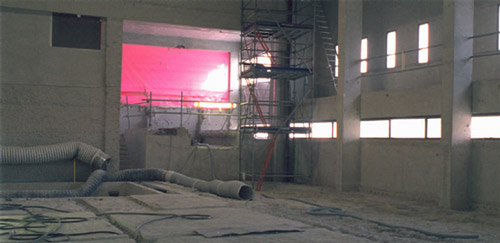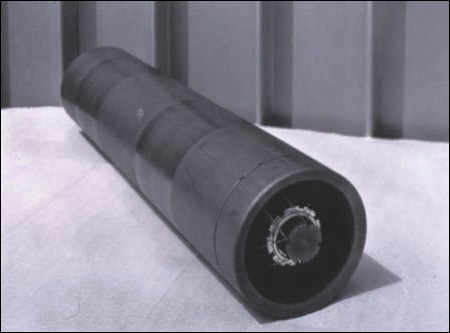Dismantling of facilities: graphite waste
Experience with dismantling nuclear power plants is only recent. The nuclear industry is still a young industry and only a few former plants are in the process of being dismantled. The SuperPhénix reactor and the facilities at Marcoule are expected to be dismantled in the near future.
Most of the reactors already shut down in France belong to the group of gas-cooled graphite-moderated reactors (GCRs). These reactors had the advantage of not requiring enriched uranium at a time when France did not have any facilities for enriching uranium by gaseous diffusion. GCRs were originally developed to produce plutonium, but the technology was subsequently used for civil reactors. In 1973 President Georges Pompidou decided to abandon them in favour of the American pressurized water reactor.

Graphite stacks at the Chinon plant
The photo on the left shows a stack of graphite blocks at the Chinon graphite-moderator plant when it was being built. The stack is an array of columns made of hexagonal graphite bricks arranged in layers: they are hollow to allow the fuel elements to be inserted. The reflector, made from the same type of bricks, though not hollow, is around the edge. Underneath the stack there is a support area, also made of graphite, which provides biological protection. These materials, which will become waste, were in reactors A1, A2 and A3 at Chinon, and A1 and A2 at Saint-Laurent des Eaux, and a reactor at Bugey.
© ANDRA (Catalogue sheet F5-2-02)
The waste from dismantling GCRs mainly comes from the graphite used as moderator. The carbon of the graphite had to be very pure to reduce unintended neutron capture. Because of neutron capture, the bulk of the graphite became slightly radioactive over years of operation.
The last natural uranium reactor to be decommissioned in France was the Saint-Laurent des Eaux reactor in 1994. A particular feature of these reactors was their very large core. The large amount of graphite to be removed explains why there is so much graphite waste. The main radioactive elements present are cobalt-60 and carbon-14, which has a half-life of 5700 years. Consequently, graphite waste is considered to be low-level long-lived waste (LLW-LL). By 31 December 2002, 8842 m³ of graphite waste had been taken out of the reactors.

Slow dismantling of the Brennilis nuclear plant
The dismantling of a nuclear power plant, is not limited to the most sensitive and most exposed parts. The buildings, which have have been exposed to radioactivity to some extent, also have to be dismantled. The photo shows the dismantling of the former heavy water reactor at Brennilis in Brittany.
© ANDRA
At the moment only the graphite sleeves have been stored at AREVA’s sites. These ‘sleeves’ are the hollow cylindrical envelopes that surrounded the uranium fuel element and were removed when the fuel was unloaded
There are normally three phases to the dismantling of a reactor:
– phase 1, decommissioning, with the removal of all the fissile material from the core;
– phase 2, with the gradual removal of any slightly or moderately radioactive equipment and instruments;
– phase 3, which takes much longer, with the removal of everything else, regardless of its radioactivity level.
In April 2001 EDF made the decision to go straight to phase 3, total dismantling, with all six GCRs, the Brennilis heavy water reactor, the first PWR decommissioned at Chooz, and SuperPhénix. The aim of this strategy was to show the feasibility of dismantling on an industrial scale, to demonstrate the capacity to manage the waste from this, and lastly to acquire experience for the future dismantling of PWRs.

Graphite sleeve
Graphite sleeves are hollow cylindrical envelopes that surrounded the fuel elements in the first French nuclear power plants. Production of these sleeves stopped in 1994. The fuel element were removed from the sleeve when the fuel was unloaded from the reactor. The wire locks, the stainless steel wires used to hold the fuel element in place, are the source of significant cobalt-60 activity. Some 360,000 sleeves, mostly with their wire locks, are stored in two partially buried silos owned by AREVA.
© ANDRA/AREVA
It should be pointed out that dismantling pressurized water reactors will produce less waste. PWRs are water-moderated and the radioactive elements in the water are removed during operation. This was not possible with a solid moderator like graphite.
With the GCRs, most of the graphite material is still in place. EDF is planning to dismantle the moderators, reflectors and support areas from 2010, and estimates that 93% will have been removed by 2020.
In principle the cost of future dismantling is covered within the price per kilowatt-hour.
Other articles on the subject « Waste Inventory »
Recoverable materials
Inventory of reusable uranium and plutonium stocks The radioactive species present in the spent f[...]
France: waste panorama (1)
An overview of French waste categories… In France, radioactive waste is split into five cat[...]
France: waste panorama (2)
An overview of French waste categories (continued)… Low- and intermediate-level short-lived[...]
US panorama
The case of the greatest nuclear power Nuclear-powered US Navy vessels, past production of nuclea[...]
Various radioactive waste
Radioactive waste from many different sources… When radioactive waste is mentioned, people [...]
Mining residues
Waste from uranium extraction The residues from processing uranium ores are disposed of on the si[...]
Medicine and research
Radioactive sources, producers of waste outside the nuclear industry… Biology labora[...]
Military waste
A separate system Using the gaseous diffusion process, the AREVA Pierrelatte facility produced en[...]
Radium-bearing waste
Legacy waste – weakly radioactive but long-lived Recent and less recent industrial activities hav[...]
Waste from Industry
Obsolete radioactive sources, the legacy of radium applications There are numerous industrial app[...]